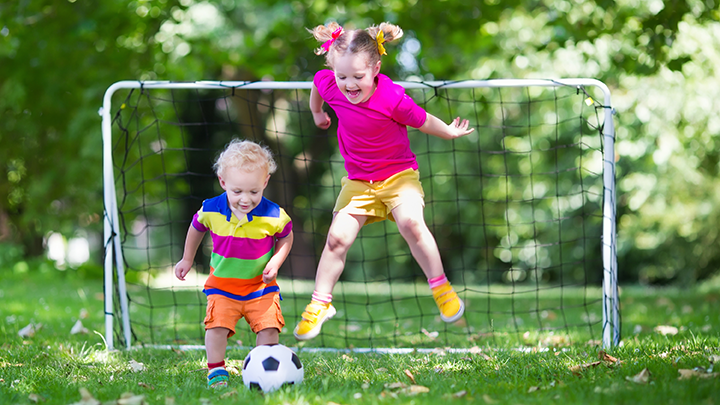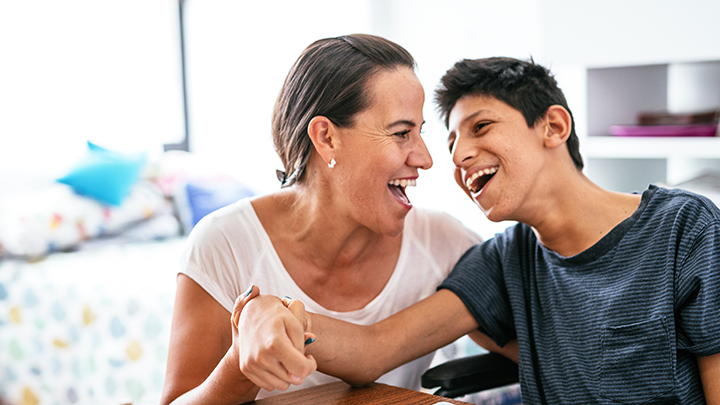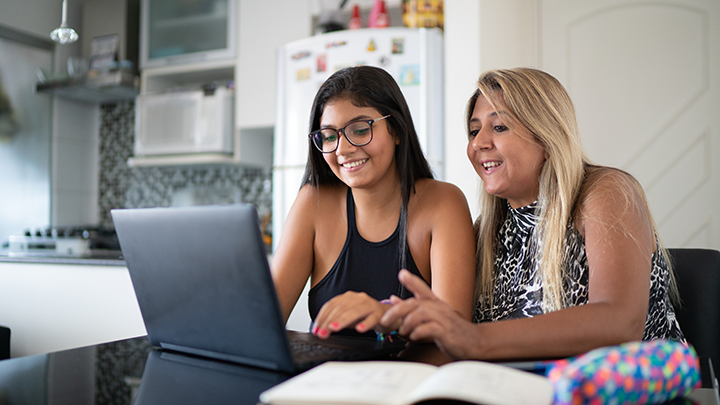
June 11, 2020
Babies learn how to move by reaching for and holding items and exploring how they look, feel and taste.
The Edmonton Public Library’s Daily Five is a list of activities to help stimulate brain activity and cognitive development. Those activities include reading, writing, singing, talking and playing together.
Small spaces don’t have to limit the fun. Areas such as kitchen tables and living room tables can be turned into craft areas and living areas can be cleared to make space for active games. Here are a few ideas for indoor games in small spaces.

Activity is key to keeping toddlers happy and healthy. Luckily, at this age, a simple game of kick the ball helps them explore their environment.

Having school-age kids draw a picture of what they enjoyed best about a virtual field trip helps them retain what they saw and learned.

With a computer at their fingertips, teenagers can explore the world through cybertours of museums and countries.

Adults need playtime, too. Set aside a few minutes of your own every day to have fun, melt stress, combat boredom and be happy. With your kids or on your own.
We hear you! COVID-19 has greatly changed how families play and have fun. You’ve worn grooves into every board game. Everyone in the house knows the good Hide and Seek spots. You’ve done every puzzle. Twice.
Plenty of fun can still be had. And needs to be had. Our earlier Stay ‘n’ Play story talked about the importance of play. This story offer more tips, advice and suggestions for your family.
Play can be divided into three types:
You can weave all three types of play into everyday activities with your child.
Your baby begins to explore movement by reaching for and holding things. This includes you, books and toys. Toys for babies don’t need to be expensive. Household objects, such as empty containers and wooden spoons are great for exploring. Caring For Kids recommends toys be unbreakable, have no loose parts or sharp edges and be the right size.
Games such as Peek-a-Boo, stacking toys, objects that make interesting sounds and soft fabrics are good ways to help your baby explore. Learn more about playtime with your baby at the Zero to Three Foundation.
Other activities include:
Playtime for toddlers becomes more active as they begin to walk, run and explore the environment around them.
Together, you can pretend to be different animals you might see in the neighbourhood (such as squirrels, rabbits or birds) or you can kick, roll or catch a ball.
The Zero to Three Foundation’s website is filled with insight about the first three years of children’s development. The At-Home Activity Guide offers great practical tips about spending days with your little ones.
Activities include:
At this age, your children’s world begins to expand as they learn and explore outside the home.
While museums, libraries and galleries are gradually beginning to open, you can also safely visit them online. Together with your child, you can take a virtual field trip to places such as the Royal Tyrrell Museum or the San Diego Zoo. Afterwards, children can:
Find more virtual tours at the YMCA of Northern Alberta, as well as science experiments, creative crafts and outdoor activities.
The TELUS World of Science brings the wonder of science into your family’s home. The Calgary-based science centre offers do-it-yourself science experiments for the whole family.
For example, in one cool experiment you make invisible ink. See how oxidization can reveal secret messages.
What you need:
What you do:
The Government of Alberta also has online collections available from the Provincial Archives of Alberta, the Provincial Art collection, the Alberta Foundation of the Arts and the Royal Tyrrell Museum.
At the Provincial Archives, you can explore Alberta’s history through art collections and books, maps and photos.
Try the Apple School’s Home Challenges. It offers many fitness activities for the whole family. Among them are: 12 Days of Fitness, Don’t Hibernate—Participate! And the Family Olympics Challenge.
Recess is a fun and active part of the day for school-aged children. Make it part of your day at home with Recess Guardians’ YouTube channel. The Saskatchewan organization posts several simple, whimsical activities a week to get the whole family up and moving.
Examples include:
It might be tough for teens to adjust to staying home during this pandemic. They may be missing friends and important milestones, such as graduations, sporting events or awards.
To keep them busy, the Edmonton Public Library offers online resources to help make creative crafts. In addition, teens can explore thousands of titles in the Teen Book Cloud. The cloud includes e-books, enhanced novels, graphic novels, videos and audio books.
Help your teens make a digital escape with Google Arts and Culture. They can explore more than 2,000 museums in 80-plus countries. Destinations include the streets of Hong Kong, England’s Dulwich Picture Gallery and contemporary Asian art at the Singapore Art Gallery.
To get teens up and moving, the YMCA provides virtual fitness classes. YThrive GROW workouts help kids build balance, strength and endurance. Workouts are available for all ages and abilities.
You can also encourage your teens to be active outdoors. They can be inline skating, cycling, skateboarding, walking and running.
Adults need playtime, too. Set aside a few minutes of your own every day to have fun, melt stress, combat boredom and be happy.
AHS’ Coping at Home for Families has two-dozen pages of suggestions for adults and kids. Those sure to appeal to grown-ups include:
Learn how to make or fix almost anything at instructables.com. which includes step-by-step instructions for electronics, woodworking, crafts, cooking and more. Examples include: a time-delay switch circuit, how to make a giant cardboard dragon, pet furniture from wood scraps and brussel sprouts with teriyaki sauce.
For parents, it can be overwhelming trying to balance playtime and everyday work. When you take care of your own needs, you are able to create a healthy family space. Take time for yourself to get fresh air, read a book and watch a movie.
And if you’re living with a spouse or partner, make time for one another. Plan a simple ‘date’ with your partner. Make time for intimacy, provided, of course, neither of you have any symptoms of COVID-19.
It’s healthy to get outside. Take advantage of warmer weather to play outdoors. Jump, run, climb, swing, balance and roll while being creative, practising skills, challenging yourself and exploring.
Kids can connect with nature by climbing trees, throwing rocks in streams, jumping through tall grass, inventing new games or just digging in the sand or mud.
When children are outside, they find any number of ways to play.
Keep a close eye on your children and remind them of social distancing rules. Wash hands well with soap and water when you come inside.
See our Healthy Together story on summer safety.
After an active day with kids and teens, change it up by setting aside some quiet time to relax. EPL From Home provides resources for all ages.
For three- to five-year-olds, Storytime Station offers songs and rhymes to help develop early literacy.
For teens and adults looking to learn more about Canada, visit Canadian Geographic (free digital subscription with in-app purchases). Or explore the world with the entire archive of National Geographic; subscribe for $12(US) a year.